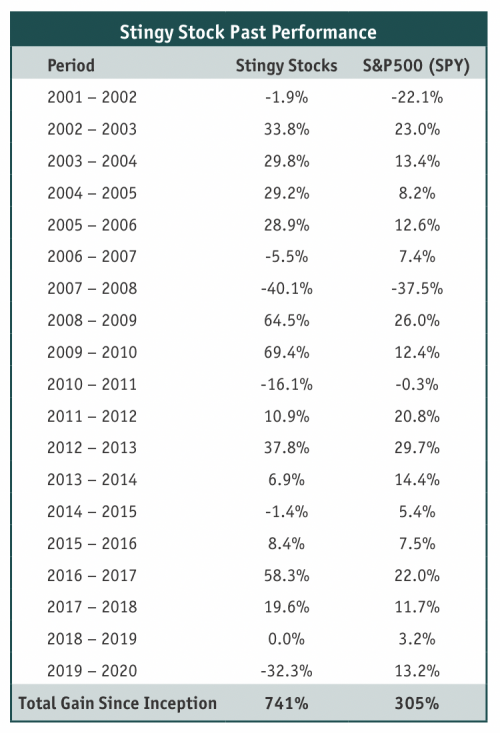10 Stingy Stocks For 2021

The Stingy Stock strategy aims to beat the S&P 500 by picking value stocks from within the index itself. It uses a strict numbers-based approach that has performed well over the long term with ups and downs along the way.
It’s been a bad year for the Stingy Stocks and for value stocks more generally. The Stingy Stocks lost a whopping 32.3% since my last update. The inclusion of a couple of airlines and energy firms in last year’s portfolio hurt during the COVID crash. The S&P 500, as represented by the SPY exchange traded fund (ETF), enjoyed a 13.2% gain thanks in large part to the giant high-tech firms that benefited as people moved online. It represents a win for the index, which beat the Stingy Stocks in eight of the last 19 outings.

Despite last year’s loss, the Stingy Stocks portfolio remains the winner over the long term. It gained an average of 12.0% per year since the portfolio began at the end of 2001. By way of comparison, the S&P 500 ETF climbed 7.8% per year over the same period. The Stingy Stocks outperformed the index by an average of 4.2 percentage points annually.
To put that into perspective, if you had split $100,000 equally among the original Stingy Stocks at the end of 2001 and moved into the new stocks each year, your portfolio would now be worth about $841,000. On the other hand, an investment in the index ETF would be worth about $405,000.
You can see the full performance record in the accompanying table. But be aware that the returns do not include commissions or other trading frictions. They do include dividends, which are reinvested roughly annually when each year’s stocks are selected.
The Stingy Stock method starts its hunt for good value stocks with the companies in the venerable S&P 500 index. The index contains some of the largest businesses in the U.S., which tend to be more stable than smaller firms.
Continuing the safety theme, the method focuses in on firms that have some earnings and some cash flows over the last year. After all, a business is less likely to go bankrupt when it is profitable and has cash coming in the door.
After putting a few safety factors in place, it’s time to hunt for bargains. The method does so by picking stocks with price-to-sales ratios of less than one. Preference is then given to stocks with modest price-to-earnings ratios. I also add a few secret ingredients to the mix along the way.
Crunching the numbers on September 25, 2020 yields the 10 Stingy Stocks for the year. They are: Allstate (ALL), Anthem (ANTM), CVS Health (CVS), Hanesbrands (HBI), HP (HPQ), Kroger (KR), Lumen Technologies (LUMN), MetLife (MET), Principal Financial (PFG), and WestRock (WRK). (Disclosure: I owned some of these stocks prior to the formation of this year’s list.)
The Stingy Stock portfolio sports an average price-to-sales ratio of 0.5, an average price-to-earnings ratio of 8.4, and an average dividend yield of four per cent.
As always, before buying any stock, do your own due diligence. Make sure the situation hasn’t changed in some important way. Read the latest press releases and regulatory filings. Scan news stories for any important developments and make sure it’s a good fit for your portfolio. Be careful out there.
Norman Rothery, PhD, CFA, Founder of StingyInvestor.com, Toronto, ON (416) 243-9580, rothery@stingyinvestor.com, www.stingyinvestor.com

